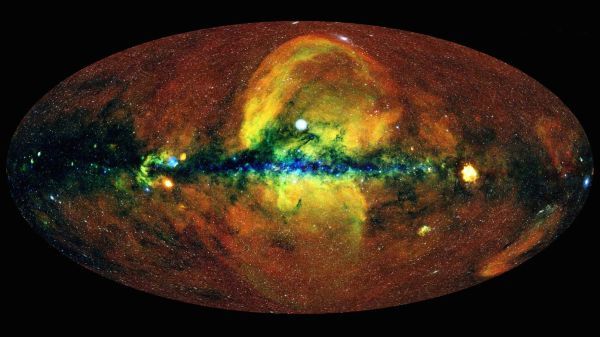Gargantuan 'Fermi bubbles' are the result of a 100,000-year-long black hole explosion, study suggest
Last edited Tue Mar 15, 2022, 10:46 PM - Edit history (1)
By Brandon Specktor published about 19 hours ago
Our galaxy's supermassive black hole had a real mean streak.

The eROSITA bubbles, detected in 2020, glow in X-rays as an ancient shock wave
pushes gas through the Milky Way
(Image credit:
Jeremy Sanders/Hermann Brunner/Andrea Merloni/Eugene Churazov/Marat Gilfanov/IKI/eSASS/MPE)
Two of the strangest, most colossal structures in the Milky Way may have formed in a 100,000-year-long explosion at our galaxy's center, new research suggests.
Those structures — named the Fermi bubbles and eROSITA bubbles after the respective telescopes that discovered them — straddle the Milky Way's center in an enormous hourglass shape, with one set of bubbles stretching more than 25,000 light-years above the galactic plane, and the other set stretching just as far below it.
The two sets of bubbles overlap with each other, but they appear to be made of fundamentally different stuff. The Fermi bubbles, filled with ultra-fast particles called cosmic rays, can only be spotted by telescopes that detect high-energy gamma rays, while the eROSITA bubbles — filled with blazing hot gas — are only visible as X-rays. Scientists dispute their origins, but one thing about the bubbles is clear: They are the result of an ancient and powerful explosion that ignited somewhere near the galaxy's center long ago.
Now, in a new study published March 7 in the journal Nature Astronomy, researchers describe how they simulated the explosive history of the Fermi and eROSITA bubbles to determine exactly where, when and how they were created. Using data from both the gamma-ray and X-ray surveys that uncovered the mysterious structures, the study authors show that both sets of bubbles likely resulted from a lengthy outburst from the supermassive black hole at the center of our galaxy, beginning 2.6 million years ago.
More:
https://www.livescience.com/fermi-bubbles-erosita-bubbles-explanation
